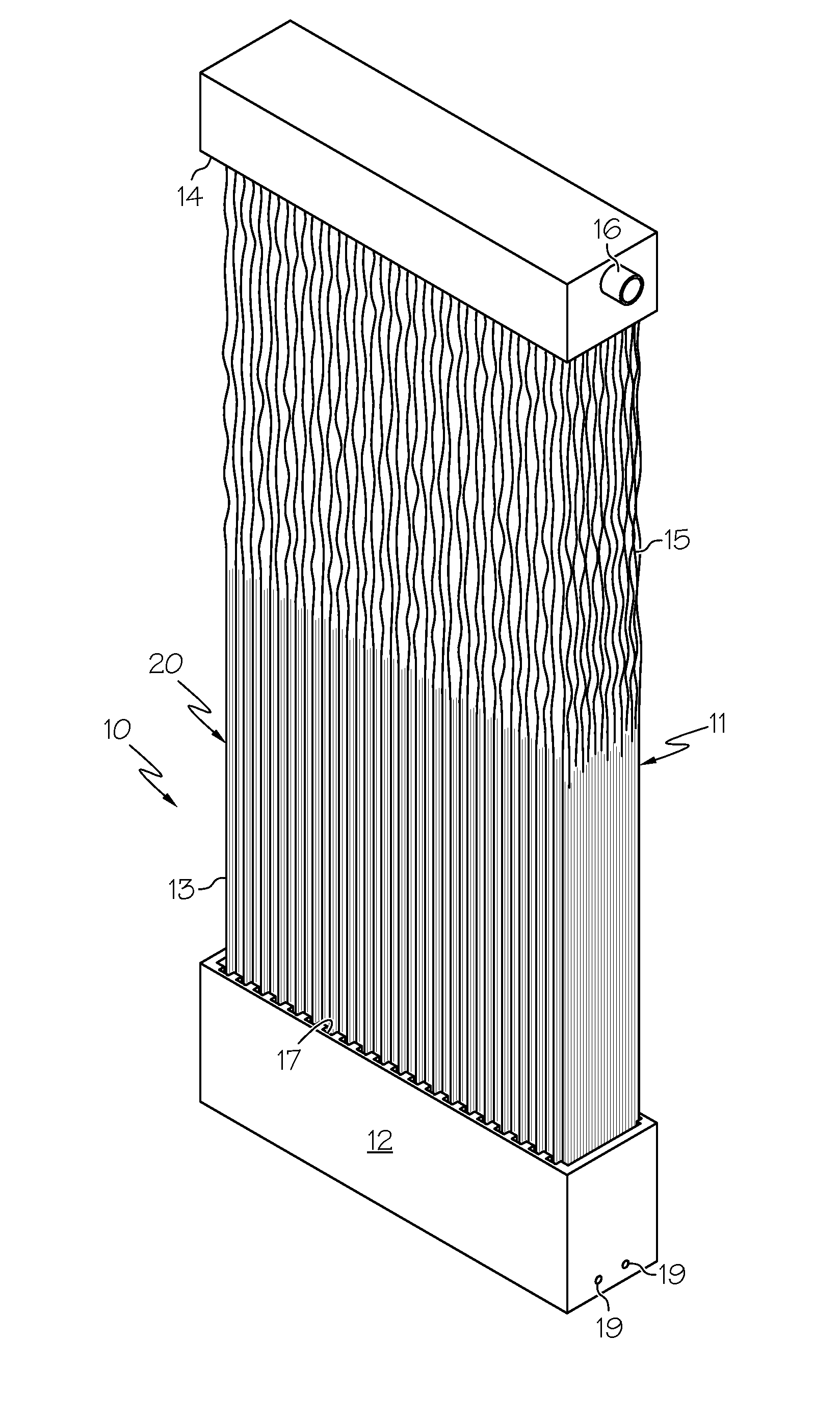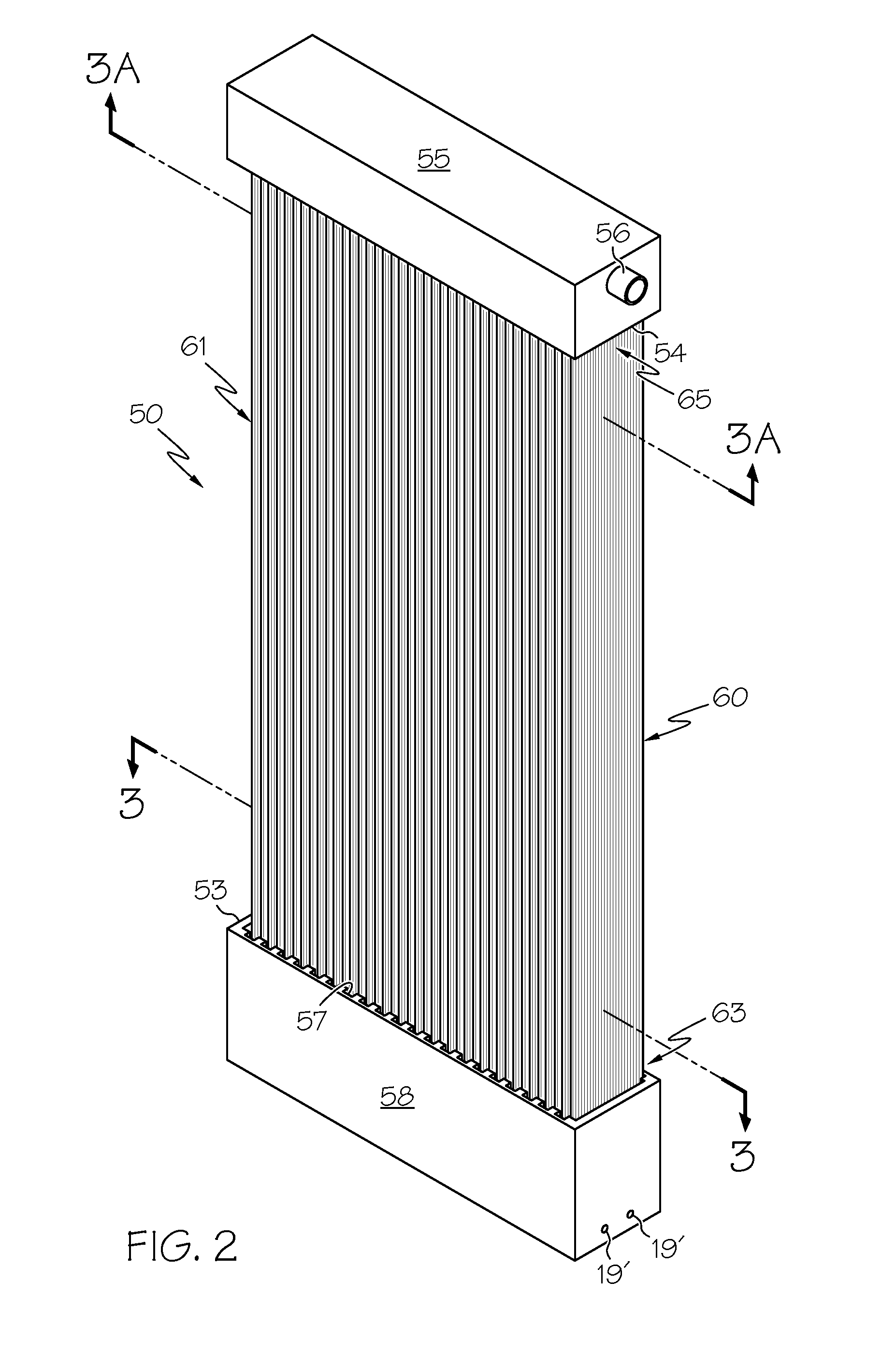Hollow fiber membrane module with miniskeins in miniheaders having a zig-zag configuration
a technology of hollow fiber membrane and miniskeins, which is applied in the field of modules of microporous hollow fiber membrane, can solve the problems of impeded filtration, high cost of using the module, and little indication, and achieve the effect of saving the cost of operation of the filtration process and efficient use of air
- Summary
- Abstract
- Description
- Claims
- Application Information
AI Technical Summary
Benefits of technology
Problems solved by technology
Method used
Image
Examples
first embodiment
[0085]In a miniheader, the lower portions of a first pair of arrays are securely adhered to a fiber-mounting strip. The term “strip” refers to a laminar, heat-stable, rigid material of arbitrary length, cut to length as needed, which will not bend during operation of the module sufficiently to have a lower miniheader come out of the slots in the aerator box in which the miniheader is mounted. The strip has a generally uniform width in the range from about 0.5 cm-5 cm, preferably 1-3 cm wide, and uniform thickness in the range from about 0.5 mm-5 mm, preferably 1 mm-2 mm thick, depending upon the diameter and number of fibers to be used in an array, the type of adhesive used, and the tensile strength at yield, hardness and impact strength of the material. Preferred is a synthetic resinous material such as a lower C2-C4 polyolefin, PVC or ABS, which material has a tensile strength @ yield (ASTM D638) of at least 40 MPa; a hardness of at least 50 Shore D (ASTM D2240); and impact streng...
second embodiment
[0088]In a miniheader, each array is adhesively secured, back-to-back, preferably with a meltable adhesive ribbon, and without a fiber-mounting strip. The opposed skein-mounting means is provided with individual skein-mounting tabs (referred to as “mounting tabs”). The mounting tabs may be provided with either (i) opposed stub-strips to each of which an end-portion of an array is adhesively secured so that the stub-strips are integrated into the miniheader, or (ii) separate, individual T-pins inserted behind fibers in arrays near opposed ends of a miniheader, after it is formed. The individual T-pins are preferably non-removably secured within the lower portion of a miniskein for up-and-down movement in the box. Whether stub-strips or T-pins, such mounting tabs are held in opposed vertical slots in the longitudinal walls of the box, and are movable upward when the fibers contract longitudinally, preventing them from breaking.
[0089]Irrespective of how the upper portions of the fibers...
third embodiment
[0119]a miniheader is without a mounting strip and without stub-strips. In this embodiment, a miniheader is assembled as follows: A continuous fiber is wound onto the non-stick surface of a sb-roller in cooperation with an intermediate roller to form a first layer of wound fiber onto which a strip of meltable adhesive is pressed. The continuous fiber is cut, and a second layer of fiber is wound onto the sb-roller, directly above the first wound layer, and a strip of meltable adhesive is pressed onto it before the fiber is cut. Additional layers of fiber may be wound onto the sb-roller, each being adhered to the one beneath it, as before, to form a stack of fibers which is cut from the sb-roller to provide multiple miniheaders without a mounting means.
[0120]Before each miniheader is mounted in slotted box 48 or 48′ (see FIGS. 14 and 14A), the arms of T-shaped mounting pins 66′, 66″ are inserted behind end arrays (see FIG. 7A), near each end of the miniheader, to provide a mounting me...
PUM
| Property | Measurement | Unit |
|---|---|---|
| included angle | aaaaa | aaaaa |
| thickness | aaaaa | aaaaa |
| diameter | aaaaa | aaaaa |
Abstract
Description
Claims
Application Information
 Login to View More
Login to View More - R&D
- Intellectual Property
- Life Sciences
- Materials
- Tech Scout
- Unparalleled Data Quality
- Higher Quality Content
- 60% Fewer Hallucinations
Browse by: Latest US Patents, China's latest patents, Technical Efficacy Thesaurus, Application Domain, Technology Topic, Popular Technical Reports.
© 2025 PatSnap. All rights reserved.Legal|Privacy policy|Modern Slavery Act Transparency Statement|Sitemap|About US| Contact US: help@patsnap.com



